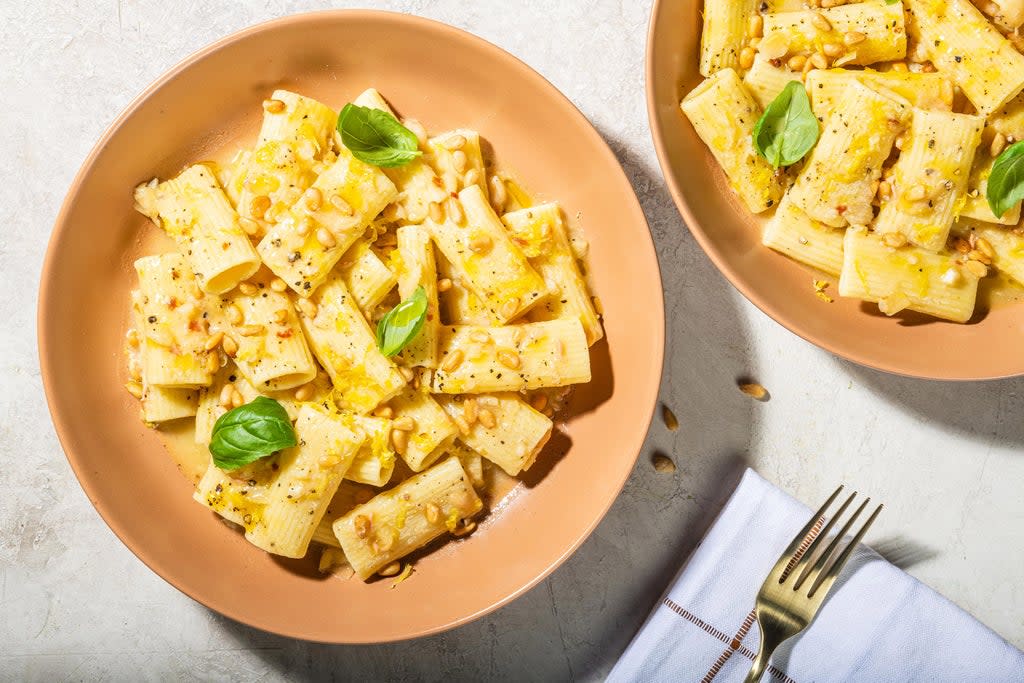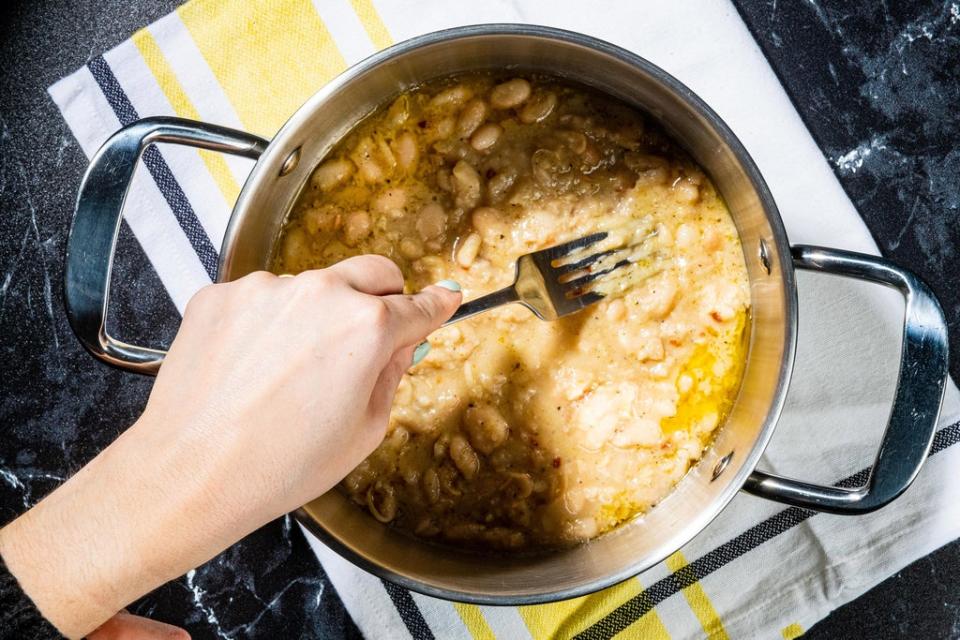Cream cannellini bean rigatoni they’ll never know is vegan

- Oops!Something went wrong.Please try again later.
I made wraps for my husband and foster son the other day: whole wheat tortillas I rolled around baby spinach, warm hummus with chickpeas and cherry tomatoes, plus some leftover cooked turkey mince for them and a little cauliflower salad for me.
The 13-year-old ate his quickly, then asked me to make him another one – a common occurrence in our household. I noticed that he had a little spinach and tomato still on his plate, so I asked him to finish it before I made him seconds. “I can’t eat that,” he said. “It tastes disgusting.”
“But you just ate it inside your wrap!” I countered.
“It was covered up with other things,” he said.
The exchange made me think of Jessica Seinfeld. She made her name – as a cookbook author, anyhow – as the writer behind Deceptively Delicious, whose point was to sneak vegetables onto your kids’ plates by, say, pureeing cauliflower into mac and cheese. The book generated no small amount of controversy by advocating an idea that some critics pilloried: How can you teach children to love vegetables if they don’t know the vegetables are there?
Ever since we started parenting this teenager who would rather down a pile of chicken wings or a bowl of noodles than anything that resembles a leaf, I’m more sympathetic to her point than I was before. If you can serve your family something that tastes good and that happens to be good for them, do you need to call attention to the vegetables? Maybe not, at least not at first. Baby steps, right?

Seinfeld’s latest book, Vegan, at Times, is built on the idea that eating more plant-based meals can improve your and your family’s health, and in it she displays some of the same savvy about the kinds of foods that will appeal to the eaters and to the busy cook trying to feed them. There’s chocolate banana bread, which she calls “the first vegan item in our house that was unanimously approved”, then writes, “Full disclosure: they did not, still do not, know it is vegan”. And there’s a taco salad that uses a spiced lentil-walnut mixture she names, simply, “Meat”, quotation marks included.
I was most drawn to a recipe that combines two of my favourite things: pasta and (surprise, surprise) beans. In Seinfeld’s hands, the latter becomes a creamy sauce for the former, especially once you employ a generous amount of pasta cooking water to help turn it silky. She uses cannellini beans, amping up their flavour with garlic and red pepper flakes and topping the dish with toasted pine nuts and grated lemon zest for a little brightness.
It’s the sort of thing you can turn around in a half-hour, boiling the pasta, mashing tinned (or your own precooked) beans by hand, and tossing it all together. If you think it would help you sell the dish to an otherwise-sceptical teenager (or spouse), feel free to call it creamy rigatoni, and leave out the words “cannellini bean”. I won’t judge.
Creamy cannellini bean rigatoni
Time: 25 minutes
Serves: 4 to 6
Ingredients:
½ tsp fine salt, plus more for the pasta water and to taste
450g short pasta, such as rigatoni
30g raw unsalted pine nuts (may substitute with slivered almonds)
3 tbsp extra-virgin olive oil, plus more for serving
2 cloves garlic, pressed or finely grated
¼ tsp crushed red pepper flakes
One (440g) tin no-salt-added cannellini beans, drained and rinsed, or 280g cooked cannellini beans
¼ tsp freshly ground black pepper, plus more for serving
2 tbsp nutritional yeast (optional)
12 fresh basil leaves, for serving
Finely grated zest of 1 lemon, for serving
Method:
Bring a large pot of water to a boil, then add enough salt so it tastes like the sea. Add the pasta and cook according to the package directions. Right before you drain the pasta, reserve 470ml of the pasta water.
While the pasta cooks, in a small dry frying pan over medium heat, toast the pine nuts, tossing often, until golden brown, 3 to 5 minutes. Remove from the heat and transfer the nuts to a small heatproof bowl.
Once you drain the pasta, wipe the pot dry and return it to medium heat. Add the oil, garlic and red pepper flakes and cook, stirring, until the garlic is fragrant but not browned, about 30 seconds. Add the beans, the ½ teaspoon of salt and the black pepper, and stir to coat in the oil.
Add about 240ml of the reserved pasta water. Using a potato masher or the back of a fork, crush the beans until mostly mashed. Add the pasta and stir well to coat with the beans. Sprinkle in the nutritional yeast, if using, and stir again to combine. If the pasta mixture is a little stiff, stir in some or all of the remaining pasta water to loosen. Taste, and season with more salt, if desired, and remove from the heat.
Divide the pasta among bowls, and top with the basil leaves, pine nuts and a little more oil. Sprinkle with the lemon zest and black pepper, and serve.
How to store: Refrigerate for up to 5 days. When reheating, add water as needed to achieve a saucy consistency.
Nutrition information per serving, based on 6 | calories: 433; total fat: 12g; saturated fat: 1g; cholesterol: 0mg; sodium: 200mg; carbohydrates: 64g; dietary fibre: 6g; sugar: 3g; protein: 15g.
This analysis is an estimate based on available ingredients and this preparation. It should not substitute for a dietitian’s or nutritionist’s advice.
Recipe adapted from ‘Vegan, at Times’ by Jessica Seinfeld (Gallery Books, 2022).
© The Washington Post

